
Details
Product Name Histone H4 Chinese Name 组蛋白H4抗体 Alias H4F2; H4FN; HIST1H4; HIST2H4; HISTH4H4; methyl histone H4; H4_HUMAN; Osteogenic growth peptide; OGP. Immunogen Species Rabbit Clonality Polyclonal React Species Human, Mouse, (predicted: Rat, ) Applications WB=1:500-2000 ELISA=1:5000-10000 IHC-P=1:100-500 IHC-F=1:100-500 Flow-Cyt=1ug/Test ICC=1:100 IF=1:100-500 (Paraffin sections need antigen repair)
not yet tested in other applications.
optimal dilutions/concentrations should be determined by the end user.Theoretical molecular weight 11kDa Cellular localization The nucleus Form Liquid Concentration 1mg/ml immunogen KLH conjugated synthetic peptide derived from human Histone H4: 51-103/103 Lsotype IgG Purification affinity purified by Protein A Buffer Solution 0.01M TBS(pH7.4) with 1% BSA, 0.03% Proclin300 and 50% Glycerol. Storage Shipped at 4℃. Store at -20 °C for one year. Avoid repeated freeze/thaw cycles. Attention This product as supplied is intended for research use only, not for use in human, therapeutic or diagnostic applications. PubMed PubMed Product Detail Histones are basic nuclear proteins that are responsible for the nucleosome structure of the chromosomal fiber in eukaryotes. Nucleosomes consist of approximately 146 bp of DNA wrapped around a histone octamer composed of pairs of each of the four core histones (H2A, H2B, H3, and H4). The chromatin fiber is further compacted through the interaction of a linker histone, H1, with the DNA between the nucleosomes to form higher order chromatin structures. This gene is intronless and encodes a member of the histone H4 family. Transcripts from this gene lack polyA tails; instead, they contain a palindromic termination element. [provided by RefSeq, Jul 2008].
Function:
Core component of nucleosome. Nucleosomes wrap and compact DNA into chromatin, limiting DNA accessibility to the cellular machineries which require DNA as a template. Histones thereby play a central role in transcription regulation, DNA repair, DNA replication and chromosomal stability. DNA accessibility is regulated via a complex set of post-translational modifications of histones, also called histone code, and nucleosome remodeling.
Subunit:
The nucleosome is a histone octamer containing two molecules each of H2A, H2B, H3 and H4 assembled in one H3-H4 heterotetramer and two H2A-H2B heterodimers. The octamer wraps approximately 147 bp of DNA.
Subcellular Location:
Nucleus. Chromosome.
Post-translational modifications:
Acetylation at Lys-6 (H4K5ac), Lys-9 (H4K8ac), Lys-13 (H4K12ac) and Lys-17 (H4K16ac) occurs in coding regions of the genome but not in heterochromatin.
Citrullination at Arg-4 (H4R3ci) by PADI4 impairs methylation.
Monomethylation and asymmetric dimethylation at Arg-4 (H4R3me1 and H4R3me2a, respectively) by PRMT1 favors acetylation at Lys-9 (H4K8ac) and Lys-13 (H4K12ac). Demethylation is performed by JMJD6. Symmetric dimethylation on Arg-4 (H4R3me2s) by the PRDM1/PRMT5 complex may play a crucial role in the germ-cell lineage.
Monomethylated, dimethylated or trimethylated at Lys-21 (H4K20me1, H4K20me2, H4K20me3). Monomethylation is performed by SET8. Trimethylation is performed by SUV420H1 and SUV420H2 and induces gene silencing.
Phosphorylated by PAK2 at Ser-48 (H4S47ph). This phosphorylation increases the association of H3.3-H4 with the histone chaperone HIRA, thus promoting nucleosome assembly of H3.3-H4 and inhibiting nucleosome assembly of H3.1-H4.
Ubiquitinated by the CUL4-DDB-RBX1 complex in response to ultraviolet irradiation. This may weaken the interaction between histones and DNA and facilitate DNA accessibility to repair proteins. Monoubiquitinated at Lys-92 of histone H4 (H4K91ub1) in response to DNA damage. The exact role of H4K91ub1 in DNA damage response is still unclear but it may function as a licensing signal for additional histone H4 post-translational modifications such as H4 Lys-21 methylation (H4K20me).
Sumoylated, which is associated with transcriptional repression.
Crotonylation (Kcr) is specifically present in male germ cells and marks testis-specific genes in post-meiotic cells, including X-linked genes that escape sex chromosome inactivation in haploid cells. Crotonylation marks active promoters and enhancers and confers resistance to transcriptional repressors. It is also associated with post-meiotically activated genes on autosomes.
Similarity:
Belongs to the histone H4 family.
SWISS:
P62805
Gene ID:
8359
Database links:Entrez Gene: 121504 Human
Entrez Gene: 554313 Human
Entrez Gene: 8294 Human
Entrez Gene: 8359 Human
Entrez Gene: 8360 Human
Entrez Gene: 8361 Human
Entrez Gene: 8362 Human
Entrez Gene: 8363 Human
Entrez Gene: 8364 Human
Entrez Gene: 8365 Human
Entrez Gene: 8366 Human
Entrez Gene: 8367 Human
Entrez Gene: 8368 Human
Entrez Gene: 8370 Human
Entrez Gene: 100041230 Mouse
Entrez Gene: 100862646 Mouse
Entrez Gene: 319155 Mouse
Entrez Gene: 319156 Mouse
Entrez Gene: 319157 Mouse
Entrez Gene: 319158 Mouse
Entrez Gene: 319159 Mouse
Entrez Gene: 319160 Mouse
Entrez Gene: 319161 Mouse
Entrez Gene: 320332 Mouse
Entrez Gene: 326619 Mouse
Entrez Gene: 326620 Mouse
Entrez Gene: 69386 Mouse
Entrez Gene: 97122 Mouse
GenBank: NM_003548 Human
Omim: 142750 Human
SwissProt: P02304 Human
SwissProt: P62805 Human
SwissProt: P02304 Mouse
SwissProt: P62806 Mouse
Unigene: 143080 Human
Unigene: 247816 Human
Unigene: 248172 Human
Unigene: 248178 Human
Unigene: 248179 Human
Unigene: 278483 Human
Unigene: 352191 Human
Unigene: 46423 Human
Unigene: 528055 Human
Unigene: 533295 Human
Unigene: 55468 Human
Unigene: 591790 Human
Unigene: 655235 Human
Unigene: 662174 Human
Unigene: 706635 Human
Unigene: 742244 Human
Unigene: 14775 Mouse
Unigene: 158272 Mouse
Unigene: 227295 Mouse
Unigene: 228709 Mouse
Unigene: 246720 Mouse
Unigene: 255646 Mouse
Unigene: 260530 Mouse
Unigene: 261642 Mouse
Unigene: 261662 Mouse
Unigene: 261664 Mouse
Unigene: 377875 Mouse
Unigene: 442307 Mouse
Unigene: 486099 Mouse
Unigene: 489077 Mouse
Product Picture
Molt-4(Human) Cell Lysate at 30 ug
Primary: Anti- Histone H4 (SL23810R) at 1/1000 dilution
Secondary: IRDye800CW Goat Anti-Rabbit IgG at 1/20000 dilution
Predicted band size: 11 kD
Observed band size: 13 kD
Sample:
NIH/3T3 cell(Mouse) Lysate at 30 ug
Primary: Anti- Histone H4 (SL23810R) at 1/500 dilution
Secondary: IRDye800CW Goat Anti-Rabbit IgG at 1/20000 dilution
Predicted band size: 13kD
Observed band size: 13 kD
Sample:
A431(Human) Cell Lysate at 30 ug
Primary: Anti- Histone H4 (SL23810R) at 1/1000 dilution
Secondary: IRDye800CW Goat Anti-Rabbit IgG at 1/20000 dilution
Predicted band size: 11 kD
Observed band size: 13 kD
Sample:
Lane 1: Human Hela cell lysates
Lane 2: Human Jurkat cell lysates
Lane 3: Human HL60 cell lysates
Lane 4: Human MCF-7 cell lysates
Primary: Anti-Histone H4 (SL23810R) at 1/1000 dilution
Secondary: IRDye800CW Goat Anti-Rabbit IgG at 1/20000 dilution
Predicted band size: 11 kD
Observed band size: 13 kD
Paraformaldehyde-fixed, paraffin embedded (mouse brain tissue); Antigen retrieval by boiling in sodium citrate buffer (pH6.0) for 15min; Block endogenous peroxidase by 3% hydrogen peroxide for 20 minutes; Blocking buffer (normal goat serum) at 37°C for 30min; Antibody incubation with (Histone H4) Polyclonal Antibody, Unconjugated (SL23810R) at 1:400 overnight at 4°C, followed by operating according to SP Kit(Rabbit) (sp-0023) instructionsand DAB staining.Paraformaldehyde-fixed, paraffin embedded (Mouse small intestine); Antigen retrieval by boiling in sodium citrate buffer (pH6.0) for 15min; Block endogenous peroxidase by 3% hydrogen peroxide for 20 minutes; Blocking buffer (normal goat serum) at 37°C for 30min; Antibody incubation with (Histone H4) Polyclonal Antibody, Unconjugated (SL23810R) at 1:400 overnight at 4°C, followed by operating according to SP Kit(Rabbit) (sp-0023) instructions and DAB staining.Paraformaldehyde-fixed, paraffin embedded (Mouse liver); Antigen retrieval by boiling in sodium citrate buffer (pH6.0) for 15min; Block endogenous peroxidase by 3% hydrogen peroxide for 20 minutes; Blocking buffer (normal goat serum) at 37°C for 30min; Antibody incubation with (Histone H4) Polyclonal Antibody, Unconjugated (SL23810R) at 1:400 overnight at 4°C, followed by operating according to SP Kit(Rabbit) (sp-0023) instructionsand DAB staining.Blank control(black line):NIH/3T3.
Primary Antibody (green line): Rabbit Anti-Histone H4 antibody (SL23810R)
Dilution:1ug/Test;
Secondary Antibody(white blue line): Goat anti-rabbit IgG-AF488
Dilution: 0.5ug/Test.
Isotype control(orange line): Normal Rabbit IgG
Protocol
The cells were fixed with 4% PFA (10min at room temperature)and then permeabilized with 90% ice-cold methanol for 20 min at -20℃, The cells were then incubated in 5%BSA to block non-specific protein-protein interactions for 30 min at room temperature .Cells stained with Primary Antibody for 30 min at room temperature. The secondary antibody used for 40 min at room temperature. Acquisition of 20,000 events was performed.Blank control(black line):Hela.
Primary Antibody (green line): Rabbit Anti-IHistone H4 antibody (SL23810R)
Dilution:1ug/Test;
Secondary Antibody : Goat anti-rabbit IgG-AF488
Dilution: 0.5ug/Test.
Isotype control(orange line): Normal Rabbit IgG
Protocol
The cells were fixed with 4% PFA (10min at room temperature)and then permeabilized with 90% ice-cold methanol for 20 min at -20℃.The cells were then incubated in 5%BSA to block non-specific protein-protein interactions for 30 min at room temperature .Cells stained with Primary Antibody for 30 min at room temperature. The secondary antibody used for 40 min at room temperature. Acquisition of 20,000 events was performed.
Bought notes(bought amounts latest0)
User Comment(Total0User Comment Num)
- No comment
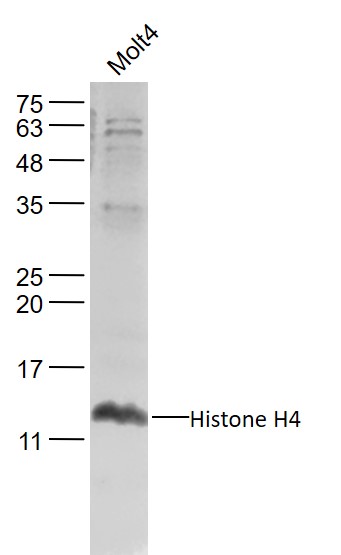
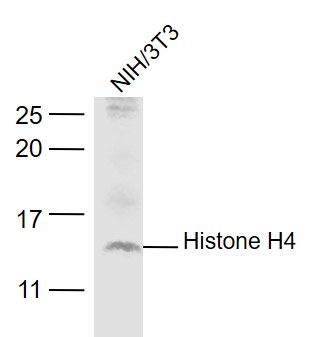
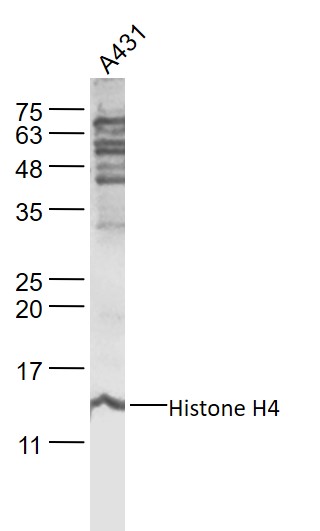
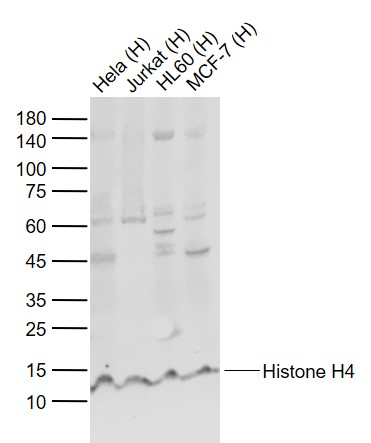
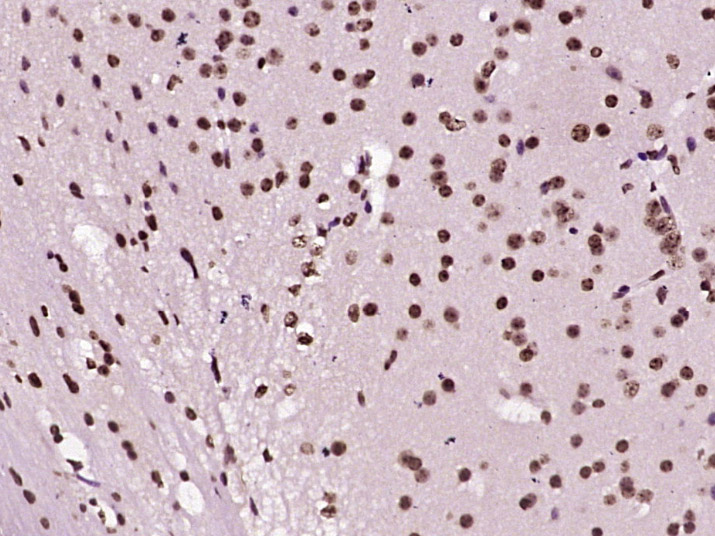
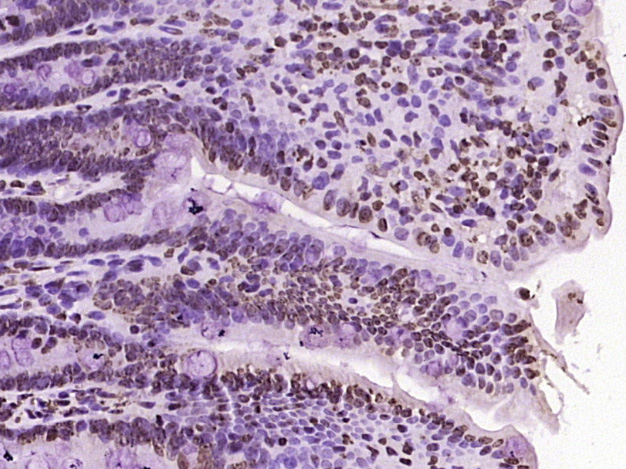
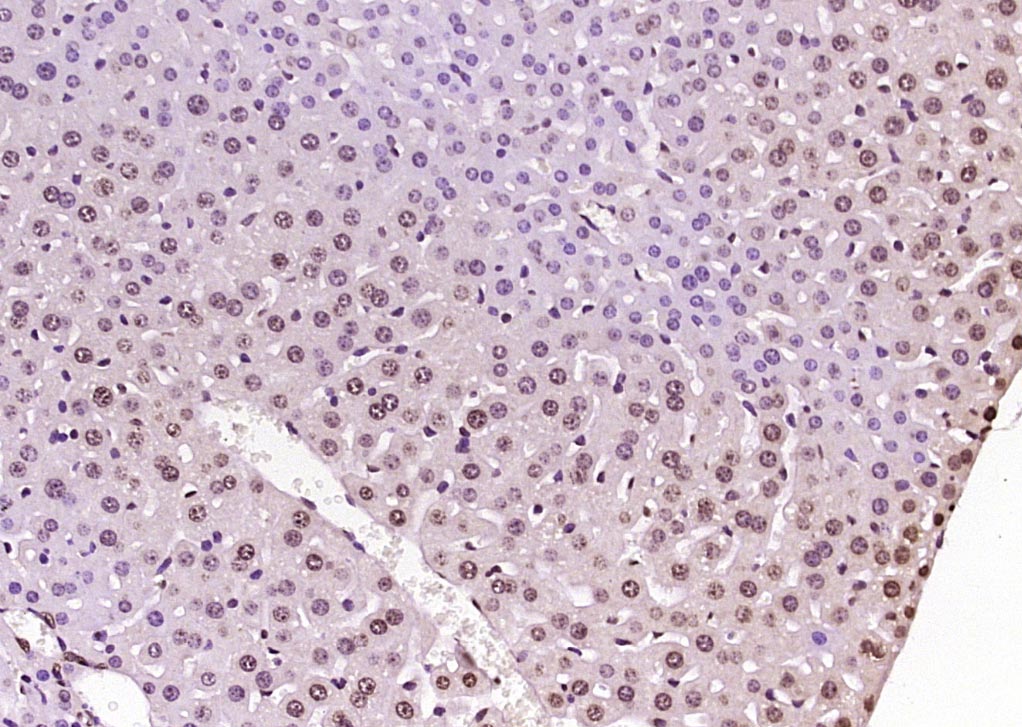
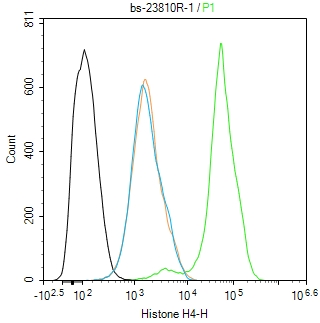
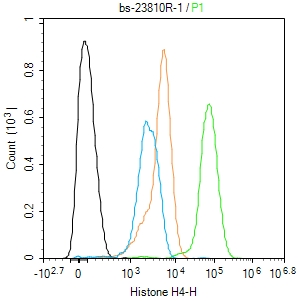


 +86 571 56623320
+86 571 56623320
 +86 18668110335
+86 18668110335

